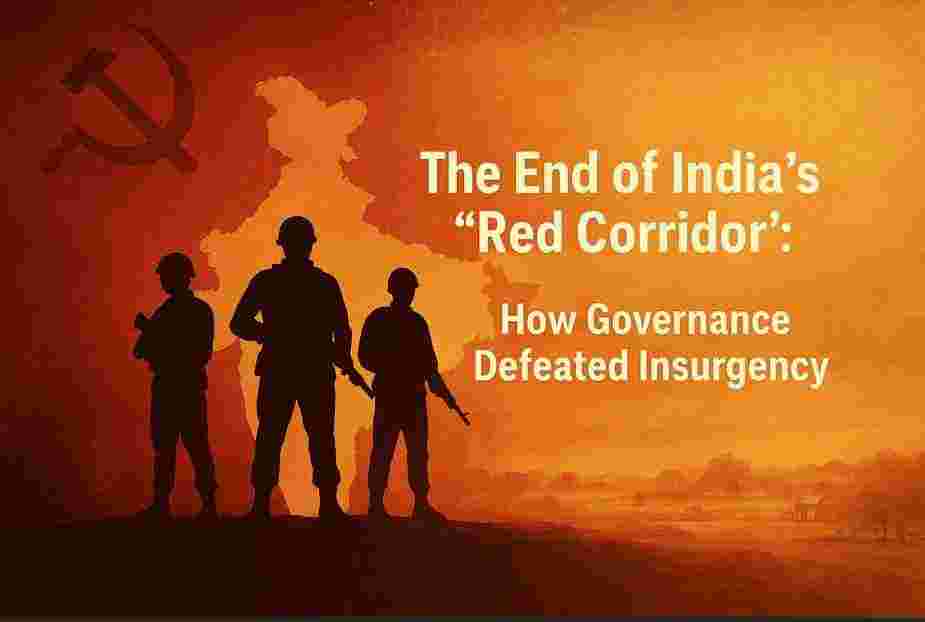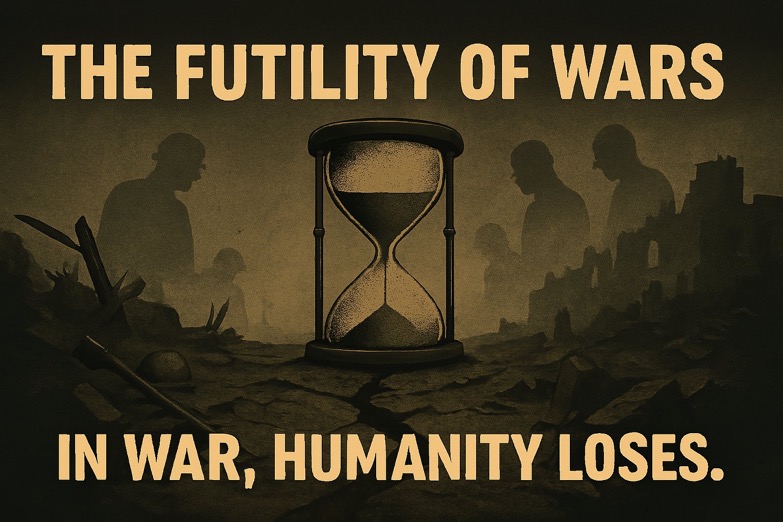
From bloodshed to ballots—India’s quiet internal security victory is one of the most significant achievements of modern statecraft.
For nearly half a century, India grappled with one of the most persistent insurgencies in the modern world—a movement that declared war not merely on the state, but on the very idea of democratic governance. The Maoist or Naxalite insurgency, rooted in the promise of a violent revolution on behalf of the oppressed, grew from a local peasant uprising in a remote corner of West Bengal into a formidable challenge spanning ten states. At its height around 2010–2011, the insurgency’s footprint covered over 90 districts, establishing shadow administrations and controlling access to forests, mines, and entire populations.
By 2025, this long and bloody chapter has nearly closed. Violence has declined by more than 90%, key leaders have been neutralized, and the once-forbidden forests of Bastar, Dantewada, and Gadchiroli are now seeing elections, mobile towers, and rural roads. What has unfolded is one of the most significant yet understated achievements of modern Indian statecraft—a transformation not only of security policy, but of governance philosophy.
The story of India’s quiet victory over left-wing extremism is not just about military operations or policing triumphs. It is about the reassertion of state legitimacy over ideology, and about how democratic governance, strategic patience, and development can ultimately outlast the gun.
I. The Roots: From Naxalbari to the Red Corridor
The Naxalite movement traces its origins to 1967, when an armed peasant uprising erupted in Naxalbari, a small village in northern West Bengal’s Darjeeling district. Charu Majumdar, Kanu Sanyal, and Jangal Santhal led local sharecroppers and tribals against landlords who monopolized land and labor under feudal structures. Their slogan—“Land to the tiller”—became the rallying cry of a revolutionary ideology that sought to replicate Mao’s China within India’s borders.
From its inception, the movement fused local grievances with global revolutionary theory. Majumdar’s “Historic Eight Documents” outlined a strategy of protracted people’s war, advocating that the Indian state could be overthrown only through armed struggle, not electoral politics. The Communist Party of India (Marxist-Leninist), or CPI(ML), was founded in 1969 to embody this vision.
State repression and ideological rigidity fragmented the early movement, but its embers spread. By the 1970s and 1980s, offshoots emerged in Andhra Pradesh, Bihar, Jharkhand, and Odisha, each adapting Maoist tactics to local contexts. The People’s War Group (PWG) in Andhra and the Maoist Communist Centre (MCC) in Bihar became particularly influential, mobilizing tribal and Dalit populations against landlords, forest contractors, and what they portrayed as exploitative state structures.
By the early 2000s, these factions consolidated into a unified front. In 2004, the PWG and MCC merged to form the Communist Party of India (Maoist), or CPI(Maoist)—a centralized, hierarchical insurgent organization with military, political, and intelligence wings. With this merger, India’s left-wing extremism entered its most lethal phase.
II. Ideology and the Economics of Insurgency
Unlike separatist insurgencies that seek secession, the Maoist movement aimed to capture the Indian state from within. Its strategy revolved around controlling rural hinterlands, forming “liberated zones,” and encircling urban centers—a reinterpretation of Mao’s doctrine of protracted people’s war.
Yet ideology alone could not sustain the rebellion. Its durability came from its symbiosis with resource-rich, governance-poor regions. The Maoists embedded themselves in areas with rich mineral deposits—iron ore, bauxite, coal, and manganese—stretching across Jharkhand, Chhattisgarh, Odisha, and parts of Maharashtra. Here, state neglect and corporate exploitation provided both recruits and revenue.
1. Parallel Governance
In large swathes of these states, the Maoists established parallel administrations. They conducted “people’s courts,” levied taxes, controlled land disputes, and enforced bans on political parties. Local bureaucrats, police, and even teachers were either driven out or forced to operate under Maoist oversight. Their “Janatana Sarkar” (people’s government) maintained civil records, agricultural taxes, and rudimentary welfare mechanisms—all aimed at replacing state legitimacy with revolutionary authority.
2. Control of Resources
The insurgency evolved into a complex shadow economy. Contractors, mining firms, and government projects were required to pay “revolutionary taxes” to ensure access and safety. Forest produce, timber, and illicit trade in minerals and wildlife provided steady financing. The Maoists also tapped into rural welfare schemes, siphoning off resources meant for development.
This dual control—over both people and resources—gave the insurgency resilience. For the inhabitants of these neglected districts, the state was often distant and extractive, while the Maoists, though coercive, were at least visible.
III. The Era of Violence and Fear
From 2000 to 2010, the Maoist insurgency became India’s deadliest internal conflict. Over 10,000 lives were lost, including thousands of civilians. The movement’s hallmark was its asymmetric warfare: ambushes, landmine blasts, assassinations, and intimidation.
Security forces became frequent targets. In 2010, the Dantewada massacre saw 76 CRPF personnel killed in a single ambush—the deadliest Maoist attack in India’s history. Similar attacks followed in Sukma, Gadchiroli, and Latehar. Railways, schools, communication towers, and roads were systematically destroyed to keep the state out and the people isolated.
Civilians were caught in between. Those suspected of being police informers were executed in kangaroo courts. Villages that refused Maoist diktats faced collective punishment—burning of homes, forced recruitment of youth, and seizure of food supplies.
Yet the state’s own counterinsurgency response often mirrored this brutality. Operations by police and paramilitary forces led to allegations of extrajudicial killings, custodial violence, and displacement. The creation of civilian militias such as Salwa Judum in Chhattisgarh—ostensibly to defend villages—degenerated into vigilante violence. The Supreme Court’s 2011 judgment declaring Salwa Judum unconstitutional was a stark reminder that the line between counterinsurgency and lawlessness can be perilously thin.
The result was a vicious cycle: violence begetting more violence, with governance receding further from the peripheries.
IV. The Turning Point: Strategic Governance Begins
By 2014, the Naxalite insurgency had reached a strategic plateau. Militarily, it was holding ground but unable to expand; politically, it was losing appeal. When Rajnath Singh assumed charge as Union Home Minister, the government recognized that the insurgency could not be extinguished solely by force.
The shift came through a calibrated approach combining security, development, and legitimacy—modeled on the “Clear–Hold–Develop” doctrine.
1. Clear: Restoring State Control
Security forces, led by the CRPF and supported by specialized state police units, focused on clearing strongholds through coordinated operations. Intelligence-sharing mechanisms were improved through joint command centers, and central forces were repositioned based on threat perception rather than political boundaries.
2. Hold: Establishing a Permanent Security Presence
Previously, forces would withdraw after operations, allowing Maoists to reoccupy vacated zones. Under the new model, security camps became semi-permanent, enabling continuous presence and reassuring locals. Police recruitment drives focused on tribal youth, transforming potential recruits for insurgents into guardians of order.
3. Develop: Delivering Governance and Infrastructure
Once security stabilized, attention turned to development. Roads, mobile towers, and bridges were prioritized as symbols of the state’s return. Between 2015 and 2022, thousands of kilometers of roads were built under the Road Requirement Plan for Left-Wing Extremism Areas. Mobile connectivity reached previously unconnected districts, breaking the information blockade that had long benefited insurgents.
Development was no longer viewed as charity—it became an instrument of counterinsurgency.
V. Amit Shah and the “Final Cleanup Phase”
If Rajnath Singh laid the groundwork, Amit Shah, as Home Minister after 2019, brought operational precision and strategic finality. His approach was defined by three parallel lines of effort: targeted elimination, financial disruption, and technological dominance.
1. Decapitation of Leadership
The Maoist command structure, long sustained by figures such as Muppala Lakshman Rao (Ganapathy), Nambala Keshava Rao (Basavaraj), and Hidma, was systematically dismantled. Through intelligence-led operations, top leaders were neutralized or isolated. The leadership vacuum weakened cohesion, triggering desertions and surrenders.
2. Financial and Logistical Disruption
The Security Related Expenditure (SRE) Scheme was expanded, allowing states to spend on logistics, intelligence, and rehabilitation. Financial flows were tracked using data analytics and satellite imagery to locate hidden camps and supply depots. Drone surveillance began mapping forest corridors, enabling preemptive operations.
3. Winning Hearts and Minds
Rehabilitation programs for surrendered cadres offered education, employment, and reintegration assistance. Welfare projects—especially in tribal belts—focused on schools, healthcare centers, and self-help groups for women. These measures undermined the Maoists’ narrative of state neglect.
By 2025, left-wing extremism-related violence had declined by over 90%. More than two-thirds of the affected districts were officially declared “Naxal-free.” What was once a corridor of insurgency has narrowed into isolated pockets.
VI. From People’s Courts to Panchayats
Numbers tell only part of the story. The deeper victory lies in the restoration of legitimacy—the return of citizens to formal governance and democratic participation.
In districts once dominated by Maoists, panchayat elections now record record turnouts. Villagers who once lived under “people’s courts” now campaign for public works, schools, and jobs. Local governance, though imperfect, has re-emerged as the primary channel of accountability.
This shift in political consciousness reflects a fundamental transformation: the Maoist insurgency, which claimed to fight on behalf of the marginalized, was defeated not by their annihilation but by their inclusion.
The Indian state’s triumph was not only coercive—it was philosophical. By addressing the root conditions of grievance, it rendered Maoist ideology obsolete.
VII. Governance as Counterinsurgency
India’s counterinsurgency model against left-wing extremism offers a distinct lesson: in a democracy, enduring victory arises not from military supremacy but from governance legitimacy.
The approach combined several mutually reinforcing dimensions:
- Security presence: ensuring safety and continuity of state institutions.
- Administrative penetration: deploying civil servants, teachers, and welfare schemes in newly secured areas.
- Development investment: integrating previously neglected zones into the national economy.
- Information connectivity: mobile networks and media access breaking Maoist control over narratives.
- Political participation: drawing citizens into formal decision-making, replacing coercion with consent.
Unlike Cold War-era counterinsurgency models that relied on overwhelming force, India’s strategy rested on strategic patience—a willingness to reclaim territory through legitimacy rather than destruction.
VIII. The Ideological Erosion of Maoism
Maoism’s decline in India also mirrors a global ideological fatigue. In the 1960s and 1970s, it spoke to agrarian injustices and anti-imperialist passions. By the 2020s, however, its rhetoric of violent revolution appeared anachronistic against the aspirations of rural youth seeking smartphones, education, and employment.
The movement’s internal contradictions hastened its demise. Its leadership aged without renewal, its doctrine failed to adapt to changing realities, and its moral claim eroded amid atrocities committed in the name of justice. When villagers who once attended “people’s courts” began queuing up for Aadhaar cards and ration schemes, the revolution’s moral center collapsed.
IX. The Challenges Ahead
While the trajectory is unmistakably positive, the story is not without caveats. The structural injustices that birthed the insurgency—land alienation, poverty, caste discrimination, and displacement due to mining—still linger.
1. The Development Paradox
Many of the same areas that once hosted insurgency are now targeted for rapid industrialization and mining. Unless the benefits of these ventures reach local populations, resentment could resurface. Development that displaces without compensation risks reproducing the very alienation Maoists once exploited.
2. Human Rights and Rule of Law
Counterinsurgency operations must remain anchored in legality and human rights. The temptation to equate dissent with insurgency, or to justify excesses in the name of security, can undermine the legitimacy that was so painstakingly restored.
3. Sustaining the Gains
Reintegration must go beyond surrender ceremonies. Education, livelihood opportunities, and governance capacity at the grassroots must be continuously strengthened. Without institutional depth, stability could prove fragile.
X. The Broader Meaning of Victory
The quiet defeat of the Maoist insurgency carries a resonance far beyond the jungles of central India. It represents the maturation of Indian democracy’s capacity to confront violence not only with might, but with moral and administrative resilience.
For decades, India’s internal security landscape was defined by multiplicity—separatism in the Northeast, militancy in Kashmir, communal violence, and the Maoist challenge in the heartland. Each required distinct responses. Yet the Maoist case is unique: it was not about ethnicity or religion, but ideology—a direct contest between the democratic state and a revolutionary alternative.
That the state prevailed without suspending democracy, without large-scale militarization, and while expanding developmental governance marks a watershed moment.
XI. The Philosophy of Strategic Patience
This victory also embodies a deeper current in Indian strategic thought: the idea of strategic patience—to wait, to integrate, and to transform rather than annihilate. It is a logic consistent with the broader vision of Indian governance that seeks unity through assimilation, not conquest.
Where colonial powers viewed insurgency as pathology, India treated it as a governance deficit. By addressing it through inclusion, the state reaffirmed the democratic principle that legitimacy cannot be commanded—it must be earned.
The decline of Maoism is thus both a security and civilizational achievement. It shows that the endurance of Indian democracy lies in its ability to absorb dissent, even violent dissent, and convert it into dialogue.
Conclusion: From the Red Corridor to the Republic’s Core
A decade ago, the Red Corridor represented India’s ungoverned frontier—a geography of despair where the writ of the state was replaced by the rule of the gun. Today, that corridor has narrowed to a handful of forest pockets, and its political relevance has all but vanished.
The journey from bloodshed to ballots, from people’s courts to panchayats, reflects more than counterinsurgency success—it reveals the deeper moral strength of the Indian state. Where ideology once ruled through fear, governance now rules through consent.
India’s quiet victory over Maoist extremism is not merely a chapter in internal security policy—it is a testament to the resilience of a democratic civilization that, despite its imperfections, has proved capable of reforming itself from within.
The Red Corridor, once a scar on the Indian map, is now a fading shadow—a reminder that even the longest insurgencies can end not with surrender, but with the triumph of governance over grievance



